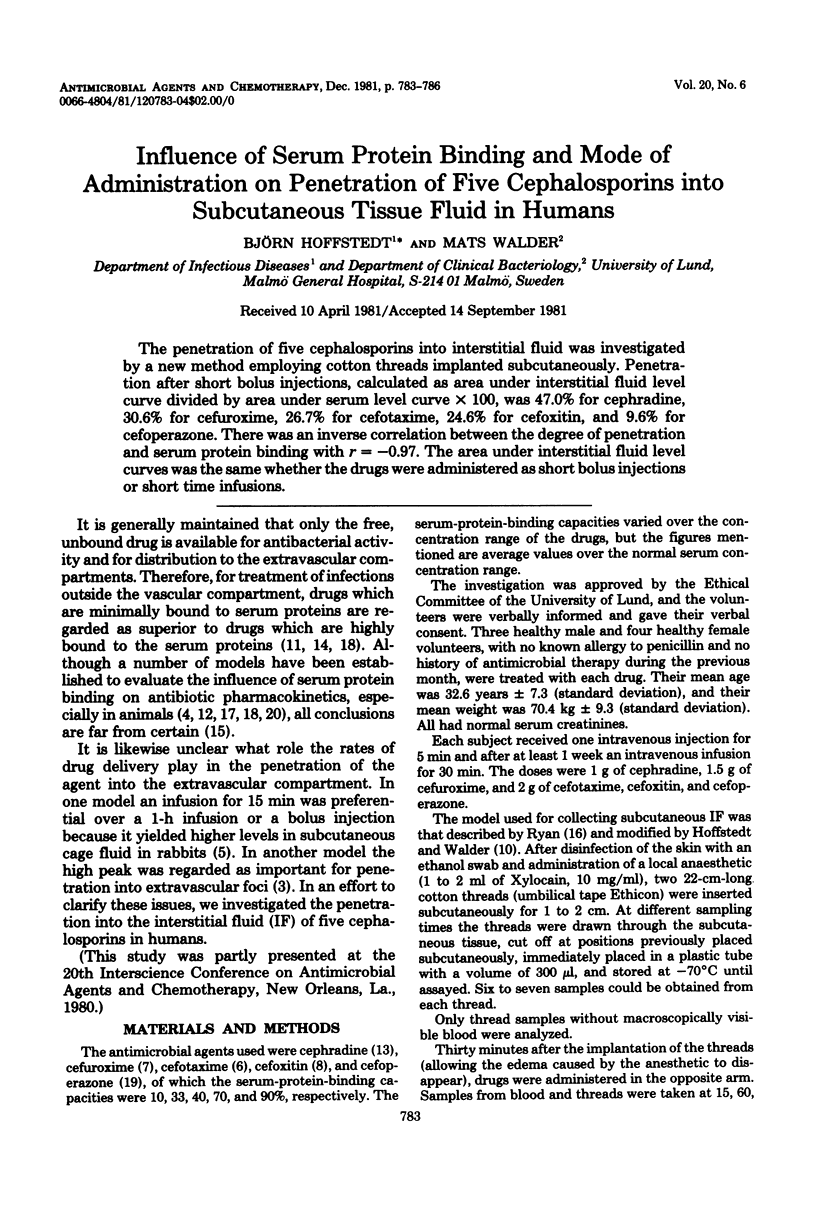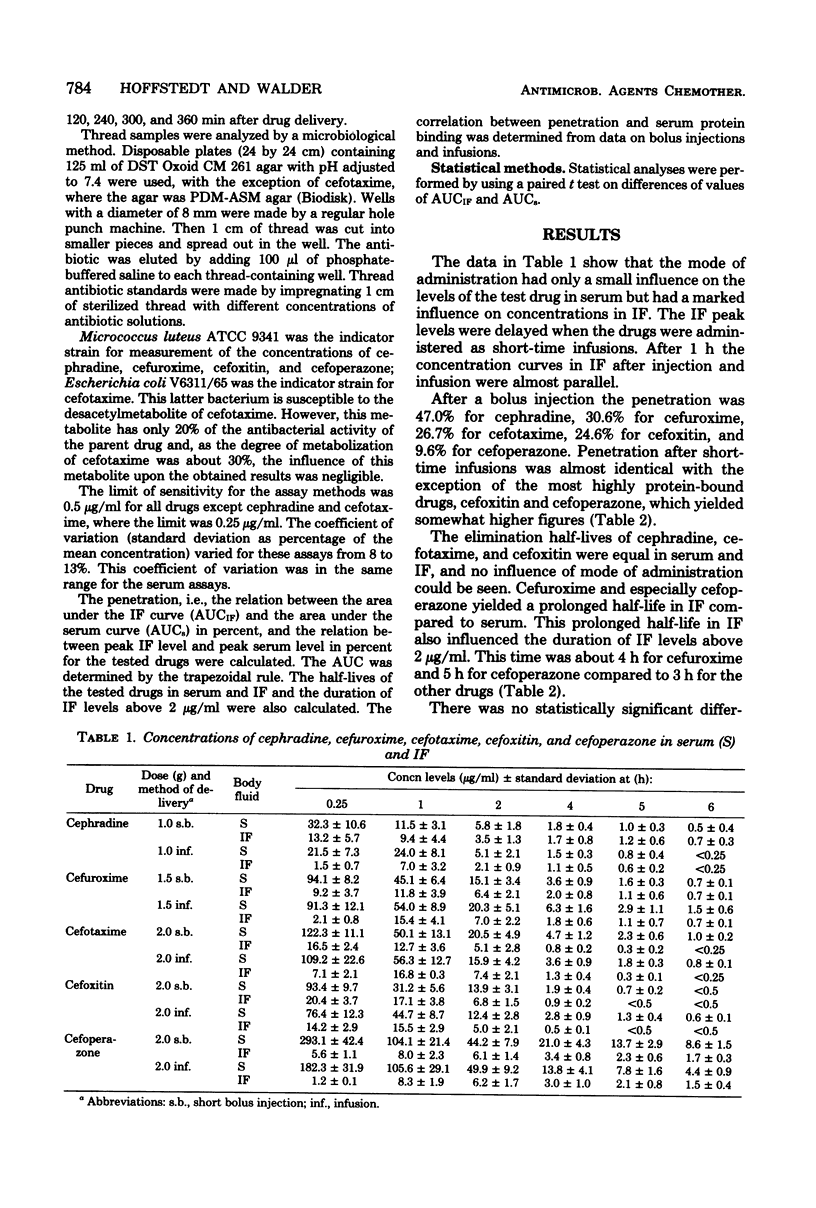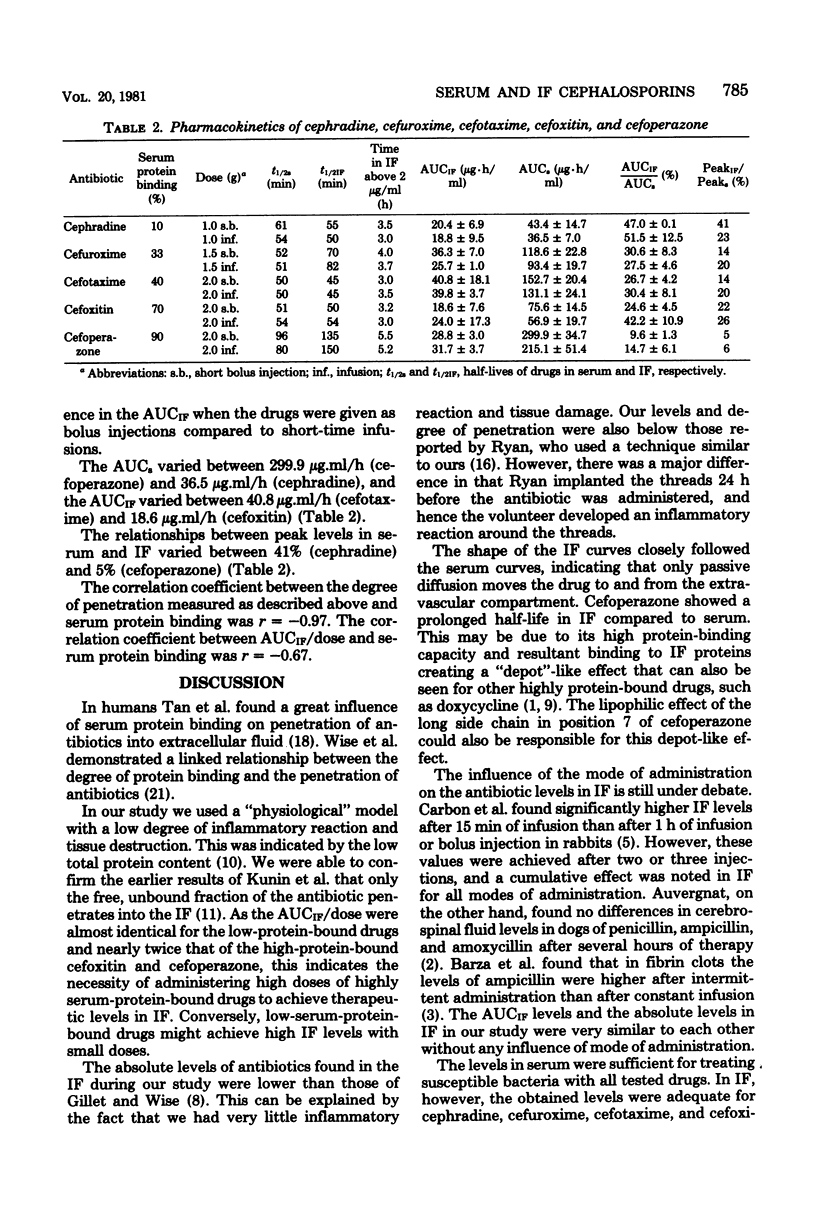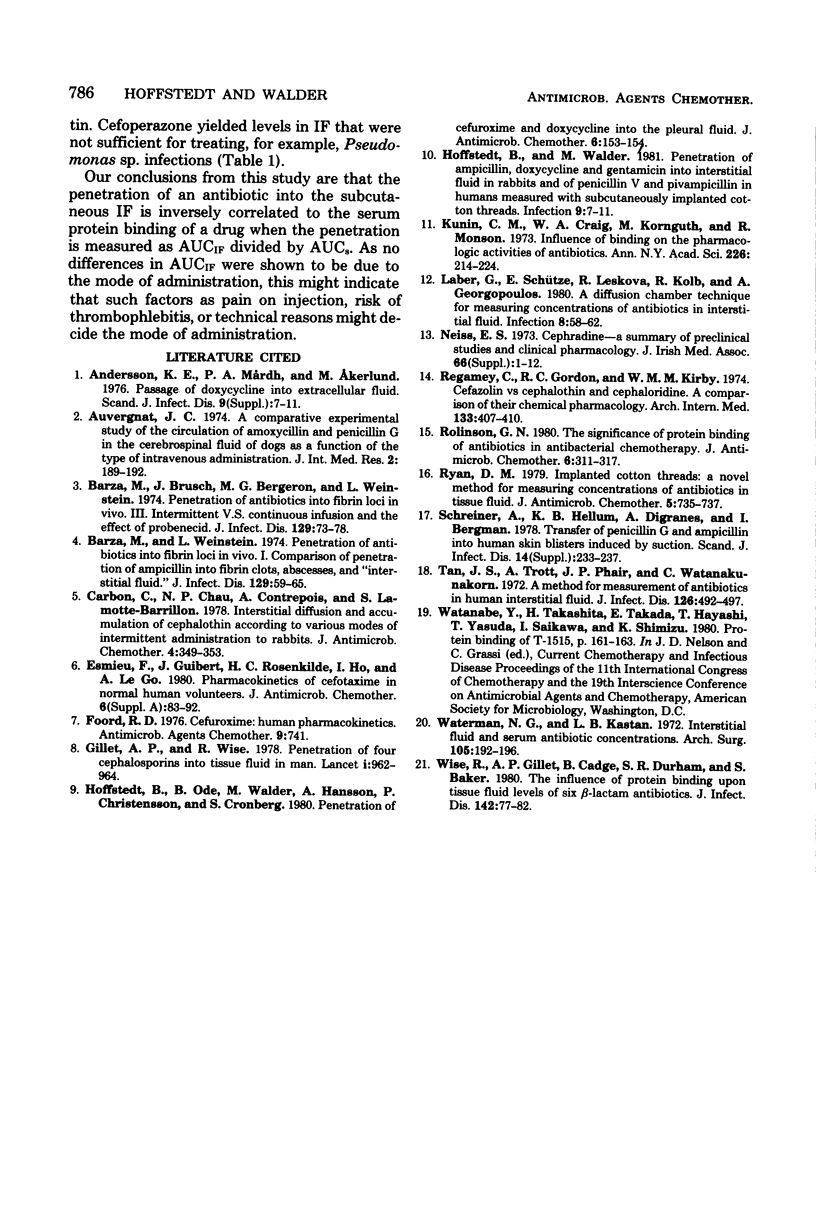Abstract
The penetration of five cephalosporins into interstitial fluid was investigated by a new method employing cotton threads implanted subcutaneously. Penetration after short bolus injections, calculated as area under interstitial fluid level curve divided by area under serum level curve x 100, was 47.0% for cephradine, 30.6% for cefuroxime, 26.7% for cefotaxime, 24.6% for cefoxitin, and 9.6% for cefoperazone. There was an inverse correlation between the degree of penetration and serum protein binding with r = -0.97. The area under interstitial fluid level curves was the same whether the drugs were administered as short bolus injections or short time infusions.
Full text
PDF



Selected References
These references are in PubMed. This may not be the complete list of references from this article.
- Andersson K. E., Mardh P. A., Akerlund M. Passage of doxycycline into extracellular fluid. Scand J Infect Dis Suppl. 1976;(9):7–11. [PubMed] [Google Scholar]
- Barza M., Brusch J., Bergeron M. G., Weinstein L. Penetration of antibiotics into fibrin loci in vivo. 3. Intermittent vs. continuous infusion and the effect of probenecid. J Infect Dis. 1974 Jan;129(1):73–78. doi: 10.1093/infdis/129.1.73. [DOI] [PubMed] [Google Scholar]
- Barza M., Weinstein L. Penetration of antibiotics into fibrin loci in vivo. I. Comparison of penetration of ampicillin into fibrin clots, abscesses, and "interstitial fluid". J Infect Dis. 1974 Jan;129(1):59–65. doi: 10.1093/infdis/129.1.59. [DOI] [PubMed] [Google Scholar]
- Carbon C., Chau N. P., Contrepois A., Lamotte-Barrillon S. Interstitial diffusion and accumulation of cephalothin according to various modes of intermittent administration to rabbits. J Antimicrob Chemother. 1978 Jul;4(4):349–353. doi: 10.1093/jac/4.4.349. [DOI] [PubMed] [Google Scholar]
- Esmieu F., Guibert J., Rosenkilde H. C., Ho I., Le Go A. Pharmacokinetics of cefotaxime in normal human volunteers. J Antimicrob Chemother. 1980 Sep;6 (Suppl A):83–92. doi: 10.1093/jac/6.suppl_a.83. [DOI] [PubMed] [Google Scholar]
- Foord R. D. Cefuroxime: human pharmacokinetics.. Antimicrob Agents Chemother. 1976 May;9(5):741–747. doi: 10.1128/aac.9.5.741. [DOI] [PMC free article] [PubMed] [Google Scholar]
- Gillett A. P., Wise Penetration of four cephalosporins into tissue fluid in man. Lancet. 1978 May 6;1(8071):962–964. doi: 10.1016/s0140-6736(78)90250-7. [DOI] [PubMed] [Google Scholar]
- Hoffstedt B., Ode B., Walder M., Hanson A., Christensson P., Cronberg S. Penetration of cefuroxime and doxycycline into the pleural fluid. J Antimicrob Chemother. 1980 Jan;6(1):153–154. doi: 10.1093/jac/6.1.153. [DOI] [PubMed] [Google Scholar]
- Kunin C. M., Craig W. A., Kornguth M., Monson R. Influence of binding on the pharmacologic activity of antibiotics. Ann N Y Acad Sci. 1973 Nov 26;226:214–224. doi: 10.1111/j.1749-6632.1973.tb20483.x. [DOI] [PubMed] [Google Scholar]
- Laber G., Schütze E., Leskova R., Kolb R., Georgopoulos A. A diffusion chamber technique for measuring concentrations of antibiotics in interstitial fluid. Infection. 1980;8(2):58–62. doi: 10.1007/BF01639147. [DOI] [PubMed] [Google Scholar]
- Neiss E. S. Cephradine--a summary of preclinical studies and clinical pharmacology. J Ir Med Assoc. 1973 Mar 24;Suppl:1–12. [PubMed] [Google Scholar]
- Regamey C., Gordon R. C., Kirby W. M. Cefazolin vs cephalothin and cephaloridine. A comparison of their clinical pharmacology. Arch Intern Med. 1974 Mar;133(3):407–410. [PubMed] [Google Scholar]
- Rolinson G. N. The significance of protein binding of antibiotics in antibacterial chemotherapy. J Antimicrob Chemother. 1980 May;6(3):311–317. doi: 10.1093/jac/6.3.311. [DOI] [PubMed] [Google Scholar]
- Ryan D. M. Implanted cotton threads; a novel method for measuring concentrations of antibiotics in tissue fluid. J Antimicrob Chemother. 1979 Nov;5(6):735–737. doi: 10.1093/jac/5.6.735. [DOI] [PubMed] [Google Scholar]
- Schreiner A., Hellum K. B., Digranes A., Bergman I. Transfer of penicillin G and ampicillin into human skin blisters induced by suction. Scand J Infect Dis Suppl. 1978;(14):233–237. [PubMed] [Google Scholar]
- Tan J. S., Trott A., Phair J. P., Watanakunakorn C. A method for measurement of antibiotics in human interstitial fluid. J Infect Dis. 1972 Nov;126(5):492–497. doi: 10.1093/infdis/126.5.492. [DOI] [PubMed] [Google Scholar]
- Waterman N. G., Kastan L. B. Interstitial fluid and serum antibiotic concentrations. Arch Surg. 1972 Aug;105(2):192–196. doi: 10.1001/archsurg.1972.04180080046008. [DOI] [PubMed] [Google Scholar]
- Wise R., Gillett A. P., Cadge B., Durham S. R., Baker S. The influence of protein binding upon tissue fluid levels of six beta-lactam antibiotics. J Infect Dis. 1980 Jul;142(1):77–82. doi: 10.1093/infdis/142.1.77. [DOI] [PubMed] [Google Scholar]


